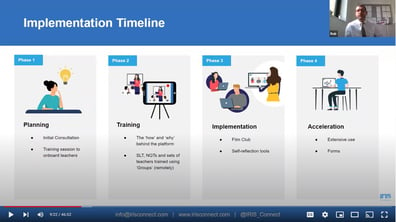From the uncertainty of the past 2 years comes a glimmer of hope: a far greater appreciation, understanding, and cognisance of the education system. The initial shock of schools and businesses closing across the globe no doubt left many of us struggling - having to adjust to working from home, a global pandemic and, for some parents, taking on the interim role of teacher. The negative effects of such rapid adjustment have been felt in all industries, though the long-term impact of COVID on the education system and student equity is still yet to be determined.

A recent survey by TeacherTapp revealed that coming out of the pandemic this academic year over 50% of teachers feel they are not provided with enough high-quality CPD and only 34% of classroom teachers feel that their CPD is helping them to become better teachers. However, it’s important to recognise that it’s not been all bad as this difficult time also sparked valuable innovation. We’ve heard of some great examples of schools within the IRIS Connect community that have been doing exemplary work to overcome the hurdles that COVID-19 has put in their way.
Celebrating academic success
How have these schools been exploring new ways to encourage professional development and improved student outcomes at a time when we’ve had to rely so heavily on technology?
In countless, innovative, extraordinary ways.
Whether the focus has been on literacy and oracy, lesson observation, or questioning (among many others) there have been schools that have gone above and beyond to uncover new ways to adapt as the world was turned upside down.
In this blog, we’d like to share some of these great examples as a source of inspiration and encouragement for other educators and members of the IRIS Connect community.
The power of collaborative groups
We know that collaboration between subject leads/experts and teachers is a powerful professional development activity that can help teachers improve their subject knowledge. It can also help them think about teaching strategies in different ways and develop new ideas and practices to try in the classroom. With evidence that teachers using collaborative practices are more innovative in the classroom, hold stronger self-efficacy beliefs, and have higher job satisfaction, showing teaching staff the power of collaborating digitally has become a priority. Sharing expertise and experiences can help others address the common issues that teaching staff often face and were intensified during the pandemic. 
One particular school, Grove Road Community Primary School, led the way at the start of the pandemic by streamlining its “central system with banks of resources, lesson clips and templates all in one place for our teachers to refer to”. Chris Harrison, co-principal at Grove Road, details how his school used IRIS Connect Groups as a way of collating high-quality exemplification and support materials’. Not only did they see the benefit in creating a bank of resources that worked well together, making it far easier to implement across the school, but they also removed formal observation as a way to improve staff efficacy and well-being.
Grove Road has also started to accumulate and build a bank of different resources, from across the school, for their staff to access on the IRIS Connect platform. Creating a system to allow staff to access relevant reflections (e.g. a whole group focussed on practising phonics) makes access to these resources easy and quick. The clips loaded are ‘collated and quality assured through learning walks, SERFs (self-evaluation reporting forms) and subject-area Film Clubs.
Furthermore, Grove Road crafted new staff development strategies throughout the pandemic, exploring how to overcome some of the barriers placed by COVID through digital means. Many of our customers create subject or phase-specific groups, which is a really quick, cost-effective approach that school leaders could take to facilitate opportunities for their staff. It also allows and encourages collaboration across whole schools and institutions within multi-academy trusts.
Another great example of the positive outcomes achieved through the use of collaborative groups is Middlesbrough College. Teaching staff at the college used video technology to create truly autonomous CPD, as well as using the groups function within the platform to develop Teaching Innovation Groups (TIGs). These groups allowed them to specifically tailor their CPD programme to meet both the teaching practice needs of the teacher and the pedagogical needs of their students.
The goal of these TIGs was to place teachers in a leading position to innovative ‘teaching and learning practice’ across all aspects of curriculum delivery, levels and subject areas within the college, through a series of simple steps that can be applied to any school and any curriculum. These include:
- Identifying areas for innovation
- Exploring this topic with like-minded colleagues
- Implementing the innovation into their practice
- Recording it for analysis
- Reflecting on what they did individually
- Sharing examples within the group to reflect collaboratively
IRIS Connect members are able to log in and create their own Teaching Innovation Group here.
Developing a personalised CPD programme
Liverpool Life Sciences UTC + Studio School launched a whole new approach to their CPD model during the pandemic that remains effective and preferred to this day. Working closely with their educational consultant at IRIS Connect, they established a personalised approach to CPD by following an instructional coaching model. Seeing as staff are already short on time, short 3x15-minute sessions were developed that could easily be integrated throughout the working day.
Each set of sessions has a particular area of focus, such as Feedback & Assessment, and is joined by a varied group of staff with different levels of experience. The first session allowed the group to determine their area of focus, and the second session was framed as a re-introduction to the IRIS Connect kit and led to the staff recording some content relevant to their chosen topic. Upon completion, they were asked to watch their recording, make time-stamped comments, and then edit their recording so they could share a specific moment with the group. The third and final session focussed on creating a group around their chosen topic where their 1-minute clips were uploaded, resulting in a bank of resources for all to access.
The time-stamped comments feature on IRIS Connect proved particularly popular among the coaches and mentors, enabling them to send immediate feedback to mentees on their lessons, helping teachers to get an objective perspective on lessons and improve aspects of delivery. The school found that IRIS Connect allowed teachers to have regular coaching conversations about their practice in an environment that they found safe - where the focus of each group allowed teaching staff to move past some of their initial concerns about appearing on camera and providing feedback on reflections.
In terms of time, it allowed for regular collaboration between coaches and teachers that would be difficult to accommodate in the day to day workings of a school if observations were required.
A different approach to lesson observation with video
It took a while to fully embrace IRIS Connect at Grove House Primary & Crossley Hall Primary, according to their old interim Executive Head, Lynette Clapham. Staff felt the usual concerns around introducing video technology into their classroom and CPD programme: “Fears around not liking the sound of our own voices, seeing ourselves on screen, or even those who were a little nervous of the technology”. The firm commitment of the school to continue creating and providing the climate for learning right for both students and teachers alike led Lynette to explore different approaches during the pandemic.
Well aware of the importance and necessity of CPD opportunities, adapting to remote working became an issue the schools had to face and respond to. After an initial first round of using IRIS Connect for lesson observations, it became apparent that video technology was going to play a huge role in allowing lessons to be observed, as well as a huge role in staff development. It almost seamlessly slipped into a culture of ‘give it a go’. Thanks to the low-pressure environment, the schools soon found themselves with a bank of reflections that staff could share, add to, and comment on. These reflections not only provided support to the staff that needed it, but also encouraged and enabled professional dialogue between staff and allowed staff to really start to take ownership of their development. Hoping to continue building on the reflections already shared, Lynette proved keen for teachers to continue sharing their strategies in order to promote rapid progress.
Advances in technology have meant that the days of traditional lesson observation, with an observer physically being present within the classroom, are long gone. However, even with these advances, in-person observation still remained on top and most popular - and it’s this reason schools like Grove House Primary & Crossley Hall Primary struggled to change to a new, digital approach. Once the initial shift had been made, largely through necessity, staff were more receptive to providing and receiving constructive feedback. The ability to analyse reflections multiple times enables staff to pick up on small nuances that they may not be otherwise aware of if it weren’t for the new perspective offered by video. The bank of resources created by staff also allowed teachers to share best practices with one another; even allowing them to compare multiple situations in a variety of reflections.
Increasing and encouraging staff engagement
With everything that’s been going on in the past 2 years, we have seen CPD slowly drop in priority across a huge number of schools globally. So, how did one school get 90%+ of their staff actively engaging with video-based CPD, all within 4 months and in the midst of a pandemic?
 Rob Harvey, ex-IRIS Connect lead at Strood Academy, shared his easy-to-replicate IRIS Connect implementation strategy, as well as how they successfully trained 100+ teachers on their journey to become more reflective practitioners. Seeing lockdown as an opportunity to explore new development options online, Rob was eager to create a plan to encourage the use of video technology in his school's CPD programme.
Rob Harvey, ex-IRIS Connect lead at Strood Academy, shared his easy-to-replicate IRIS Connect implementation strategy, as well as how they successfully trained 100+ teachers on their journey to become more reflective practitioners. Seeing lockdown as an opportunity to explore new development options online, Rob was eager to create a plan to encourage the use of video technology in his school's CPD programme.
Initially providing staff with a brief guide on how to use the equipment and the ITT area that had been developed in their online IRIS Connect platform, Rob also created a detailed survey encouraging staff to explain how they felt about using the equipment and platform. After the initial 4 week pilot, the questionnaire was re-issued and the results were in: Staff engagement and confidence were up! Mentors had originally been reluctant - having used video in the past with negative experiences (with video being used to catch teachers out, rather than providing support). Once the pilot group of ECTs and mentors understood that IRIS Connect is focused on development and progress, rather than monitoring or performance management, engagement skyrocketed.
CPD can only be truly effective when teachers are working together within a supportive culture that encourages the sharing of ideas and peer feedback so, to get the ball rolling, Rob filmed his own reflection for discussion first. In doing so, the group's receptiveness was dramatically improved from previous attempts at recording. The little quirks that teachers noticed in each other's practices weren’t seen as negative - but rather became an important part of developing a collaborative culture.
Once the initial positive feedback from the ECT/mentor group had been received, Rob was keen to get the SLT team trained and using the platform in order to encourage school-wide usage through leading by example. While recognising that work-load-wise, taking on new things wasn’t ideal from many educators' perspectives, there were 5 key points that made a huge difference to staff willingness and engagement:
- The platform's ease of use - with even the least technologically-savvy staff marvelling and the simplicity of navigating the platform, it was easier to bring staff around to the idea of using new techniques and technology.
- Support within the trust and educational consultants - a close partnership between the schools in the trust and the educational consultants at IRIS Connect meant that whatever direction the CPD of the schools were going in, everyone was very upfront and forthcoming about expectations from both sides.
- Explicit about usage - It was made clear that IRIS Connect is purely to develop teaching, and is *not* a performance management system. This created a far more low-stakes environment that teachers were receptive to.
- SLT training - through ensuring that the SLTs were making their own reflections and setting the scene, it provided a united message that managed to spread across all departments.
- Timing - Rob has been very upfront about how he used his judgement when choosing to drive usage, but it was also equally down to luck that the timing was right.
After recognising the benefits of video technology as the primary way of observing and coaching for ECTs and coaches, it was then used to help up-skill the staff at Strood Academy. Incorporating video into the weekly CPD sessions, the staff and school saw huge potential and promise in the use of forms with their recordings and developing whichever teaching principles they were focussing on.
Creating specialised forms allow observers and coaches to tally up specific elements of practice in lessons that were relevant to the focus of the term. Looking at examples from other departments also helped create an idea of a whole-school approach, further breaking down any barriers that siloed any departments. Forms were also used as part of the school's own internal research (they found the research data they obtained more relevant to the academy on a subject level, rather than a national level). For example, 2 groups of teachers were assigned different questioning types, with the coaches/middle leaders looking at these within the assigned CPD sessions. Using a pre-designed form, determined on the agreed area of focus for that week in alignment with the ECF, it was then possible to explore instances where the additional focus was required for individual staff.
How we can help
If you feel inspired by the examples above and would like to explore how your school can rejuvenate and refresh its approach to professional development, please get in touch with your dedicated IRIS Connect consultant who is more than happy to help. (If you don’t know who this is, simply send us a message here and we’ll be in touch.)
If you’re not an IRIS Connect customer yet but are keen to explore the use of video technology for CPD at your school, simply request a demo here and we’ll show you how everything works.
P.S. Has your school also used IRIS Connect in brilliant ways over the past two years? We would love to know!
Get in touch with us and let us share your school's success - even the smallest win is a huge accomplishment and deserves to be recognised.



Leave a comment:
Get blog notifications
Keep up to date with our latest professional learning blogs.